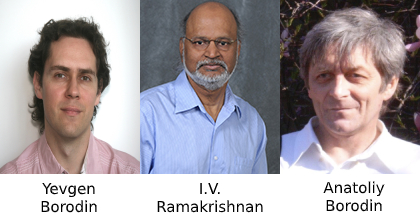Computer Science Research Team Gets NSF Grant to Develop Feel-IT Glove Device
 A father and son partnership is leading a team of Stony Brook researchers to develop a new human-computer interface to enable blind and low-vision people to better interact with computers. Yevgen Borodin, a Research Professor in the Department of Computer Science; I.V. Ramakrishnan, a Computer Science Professor and CEAS Associate Dean for Strategic Initiatives and Professor in the Department of Computer Science; and Anatoliy Borodin, a Research Scientist in the Department of Physics and Astronomy, have received a $210,000+ grant from the National Science Foundation to create their Feel-It portable hardware device.
A father and son partnership is leading a team of Stony Brook researchers to develop a new human-computer interface to enable blind and low-vision people to better interact with computers. Yevgen Borodin, a Research Professor in the Department of Computer Science; I.V. Ramakrishnan, a Computer Science Professor and CEAS Associate Dean for Strategic Initiatives and Professor in the Department of Computer Science; and Anatoliy Borodin, a Research Scientist in the Department of Physics and Astronomy, have received a $210,000+ grant from the National Science Foundation to create their Feel-It portable hardware device.
The project, a partnership between Stony Brook's Accessibility Lab and the Lighthouse Guild, aims to transform the computer interaction experiences of blind and low-vision people using haptics. Feel-IT "gloves" will allow users to interact with computers and potentially smartphones by using haptic devices on their hands and moving them on a table or any flat surface.
The team's goal is to create a single device that will make all screens accessible by touch and enable blind and low-vision people to fully participate in our digital society. The haptic feedback will provide greater accessibility for blind people to process information on the computer screen much quicker. It will reduce information overload and allow them to quickly identify the content they want to interact with.
The project will provide a blueprint for future assistive technology and advance the field of Computer Accessibility and Human Computer Interaction. Feel-IT will contribute to the rehabilitation of people affected by vision loss, promote efficient interaction with computers, improve independence, and further the goals of the Rehabilitation Act and the 21st Century Communications and Video Accessibility Act.
Samir Das, Chair of the Department of Computer Science, said “Dr. Borodin is a graduate from our department and his team’s research continues to break new ground in building assistive technologies for the low-vision community.”
The Feel-IT project will design haptic gloves to provide high-resolution tactile feedback and portability, create audio-tactile interfaces that enable exploration of the computer screen and work with standard office apps, and do human-subject research in various settings. The researchers anticipate that this project will develop methods to represent a computer screen in tactile form, provide better understanding of the strategies blind people use for audio-tactile interaction with devices, create guidelines for future similar interfaces, and allow for numerous education opportunities for students and end users.
About the Researchers
Yevgen Borodin is a Research Professor in the Department of Computer Science in the College of Engineering and Applied Sciences. He has more than 15 years of experience in Computer Accessibility, Machine Learning, and Information Retrieval and more than 25 years of experience in software development. He is an internationally known researcher recognized by numerous awards, including the 2015 MIT Technology Review Innovator Under 35 Award and FCC Chairman’s Award for Advancing Accessibility. He has co-authored more than 50 research publications on Web accessibility.
Anatoliy Borodin, also a Stony Brook Alum, is a full-time Research Scientist in the Department of Physics and Astronomy and the Department of Computer Science. His research is on fluorescence and optoelectronics, and he has experience working with electronics, light sensors and microcontrollers, as well as with manufacturing electronic devices and 3D printing.
I.V. Ramakrishnan is Associate Dean for Strategic Initiatives in the College of Engineering and Applied Sciences and Professor and in the Department of Computer Science who has more than 10 years of research experience in computer accessibility, and more than 30 years in artificial intelligence, logic, and information extraction. His research has been consistently funded by the NSF, ONR, NIH and other federal agencies. He has co-authored more than 170 papers in major journals and conferences.
